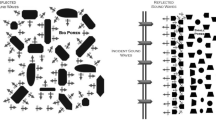Abstract
Noise is definitely a nuisance to the quality of people’s lives and health. In recent decades the public has suffered from industrial and environmental noise and its control has had a desirable impact on people’s lives. Though noise cannot be completely eliminated, it can be mitigated to a level that it is less harmful to people’s health. One of the ways for obtaining these pleasing environment is to design and use the absorbing sound materials. Fibrous and porous materials are the ordinary absorptive materials that are not good absorbers for low and mid frequency sounds. In this study, we examined the different parameters that affect the quality of absorbers, which could provide the best pattern for mid to low frequencies with the numerical and analytical models. For this purpose, three methods including measurement of absorption coefficient by impedance tube, analytical and numerical methods were used. Accuracy was determined by comparing measurement and two prediction methods. The results showed that the experimental and analytical methods provided by the Delany and Bazely and finite element (COMSOL) modeling have good adaptation. The best thickness of porous sound absorbers for low to mid frequencies f:[80–5000]Hz is about 10 cm with the air flow resistivity of 10,000–30,000 Ns/ m4.









Similar content being viewed by others
References
Lee J-K, Kim J, Rhee C-J, Jo C-H, Choi S-B. Noise reduction of passive and active hybrid panels. Smart Mater Struct. 2002;11(6):940–6.
Amares S, Sujatmika E, Hong T, Durairaj R, Hamid H. A review: characteristics of noise absorption material. J Phys Conf Ser. 2017;908(1):012005. IOP Publishing.
Oliva D, Hongisto V. Sound absorption of porous materials–accuracy of prediction methods. Appl Acoust. 2013;74(12):1473–9.
Liu S, Chen W, Zhang Y. Design optimization of porous fibrous material for maximizing absorption of sounds under set frequency bands. Appl Acoust. 2014;76:319–28.
Chen W, Liu S, Tong L, Li S. Design of multi-layered porous fibrous metals for optimal sound absorption in the low frequency range. Theor Appl Mech Lett. 2016;6(1):42–8.
Zent A, Long JT. Automotive sound absorbing material survey results. SAE Technical Paper0148–7191. 2007.
Davern WA. Perforated facings backed with porous materials as sound absorbers—An experimental study. Appl Acoust. 1977;10(2):85–112.
Zhang B, Zhang W, Zhu J. Optimization of sound absorbing performance for gradient multi-layer-assembled sintered fibrous absorbers. In: Third International Conference on Smart Materials and Nanotechnology in Engineering, vol. 8409; 2012. p. 84090C. International Society for Optics and Photonics.
Rozli Z, Zulkarnain Z. Noise control using coconut coir fiber sound absorber with porous layer backing and perforated panel. Am J Appl Sci. 2010;7(2):260–4.
Wang C-N, Torng J-H. Experimental study of the absorption characteristics of some porous fibrous materials. Appl Acoust. 2001;62(4):447–59.
Hong Z, Bo L, Guangsu H, Jia H. A novel composite sound absorber with recycled rubber particles. J Sound Vib. 2007;304(1–2):400–6.
Puranik RRPPR, Rana PP. Nonwoven acoustic textiles – a review. International Journal of Advanced Research in Engineering and Technology (IJARET). 2014;5(3):8.
Mei J, Ma G, Yang M, Yang Z, Wen W, Sheng P. Dark acoustic metamaterials as super absorbers for low-frequency sound. Nat Commun. 2012;3:756.
Fuliang GL. Development and Applications of Sound-absorbing Materials [J]. 2007;2:021.
Zulkifh R, Nor M, Tahir M, Ismail A, Nuawi M. Acoustic properties of multi-layer coir fibres sound absorption panel. J Appl Sci. 2008;8(20):3709–14.
Chen W-H, Lee F-C, Chiang D-M. On the acoustic absorption of porous materials with different surface shapes and perforated plates. J Sound Vib. 2000;237(2):337–55.
Lee F-C, Chen W-H. Acoustic transmission analysis of multi-layer absorbers. J Sound Vib. 2001;248(4):621–34.
Zwikker C, Kosten CW. Sound absorbing materials. New York City: Elsevier; 1949.
Choy Y, Huang L, Wang C. Sound propagation in and low frequency noise absorption by helium-filled porous material. JASA. 2009;126(6):3008–19.
Mechel F. Design charts for sound absorber layers. JASA. 1988;83(3):1002–13.
Meng H, Ao Q, Tang H, Xin F, Lu T. Dynamic flow resistivity based model for sound absorption of multi-layer sintered fibrous metals. SCIENCE CHINA Technol Sci. 2014;57(11):2096–105.
Din E.10534-2: acoustics-determination of sound absorption coefficient and impedance in impedance tubes-part 2: transfer-function method.
Dunn I, Davern W. Calculation of acoustic impedance of multi-layer absorbers. Appl Acoust. 1986;19(5):321–34.
Delany M, Bazley E. Acoustical properties of fibrous absorbent materials. Appl Acoust. 1970;3(2):105–16.
Allard JF, Champoux Y. New empirical equations for sound propagation in rigid frame fibrous materials. JASA. 1992;91(6):3346–53.
Mechel FP, Ver IL. Sound absorbing materials and sound absorbers. New York: Noise and Vibration Control Engineering, John Wiley & Sons; 1992.
Miki Y. Acoustical properties of porous materials-modifications of Delany-Bazley models. J Acoust Soc Jpn(E). 1990;11(1):19–24.
Qunli W. Empirical relations between acoustical properties and flow resistivity of porous plastic open-cell foam. Appl Acoust. 1988;25(3):141–8.
Wang C, Huang L. On the acoustic properties of parallel arrangement of multiple micro-perforated panel absorbers with different cavity depths. J Acoust Soc Am. 2011;130(1):208–18.
Cox T, d’Antonio P. Acoustic absorbers and diffusers: theory, design and application. United States: CRC Press, Taylor and Francis; 2016.
Azkorra Z, Pérez G, Coma J, Cabeza LF, Bures S, Álvaro JE, et al. Evaluation of green walls as a passive acoustic insulation system for buildings. Appl Acoust. 2015;89:46–56.
Seddeq HS. Factors influencing acoustic performance of sound absorptive materials. Aust J Basic Appl Sci. 2009;3(4):4610–7.
Huang Z, Wang X. Sound absorbing performance optimization based on characteristic impedance. 24th International Congress On Sound and Vibration, 23-27 July 2017, London.
Acknowledgments
This article is extracted from a Ph.D. thesis in the field of occupational health engineering. The authors would like to appreciate the Shahid Beheshti University of Medical Sciences for their technical and financial support with the grant number of 7752. The study was approved by their respective university ethics’ committee.
Author information
Authors and Affiliations
Corresponding author
Ethics declarations
Conflict of interest
The authors confirm no conflicts of interest associated with this publication.
Rights and permissions
About this article
Cite this article
Jafari, M.J., Monazam, M.R. & Kazempour, M. Providing an optimal porous absorbent pattern to reduce mid to low-frequency sounds. J Environ Health Sci Engineer 16, 289–297 (2018). https://doi.org/10.1007/s40201-018-0317-3
Received:
Accepted:
Published:
Issue Date:
DOI: https://doi.org/10.1007/s40201-018-0317-3




